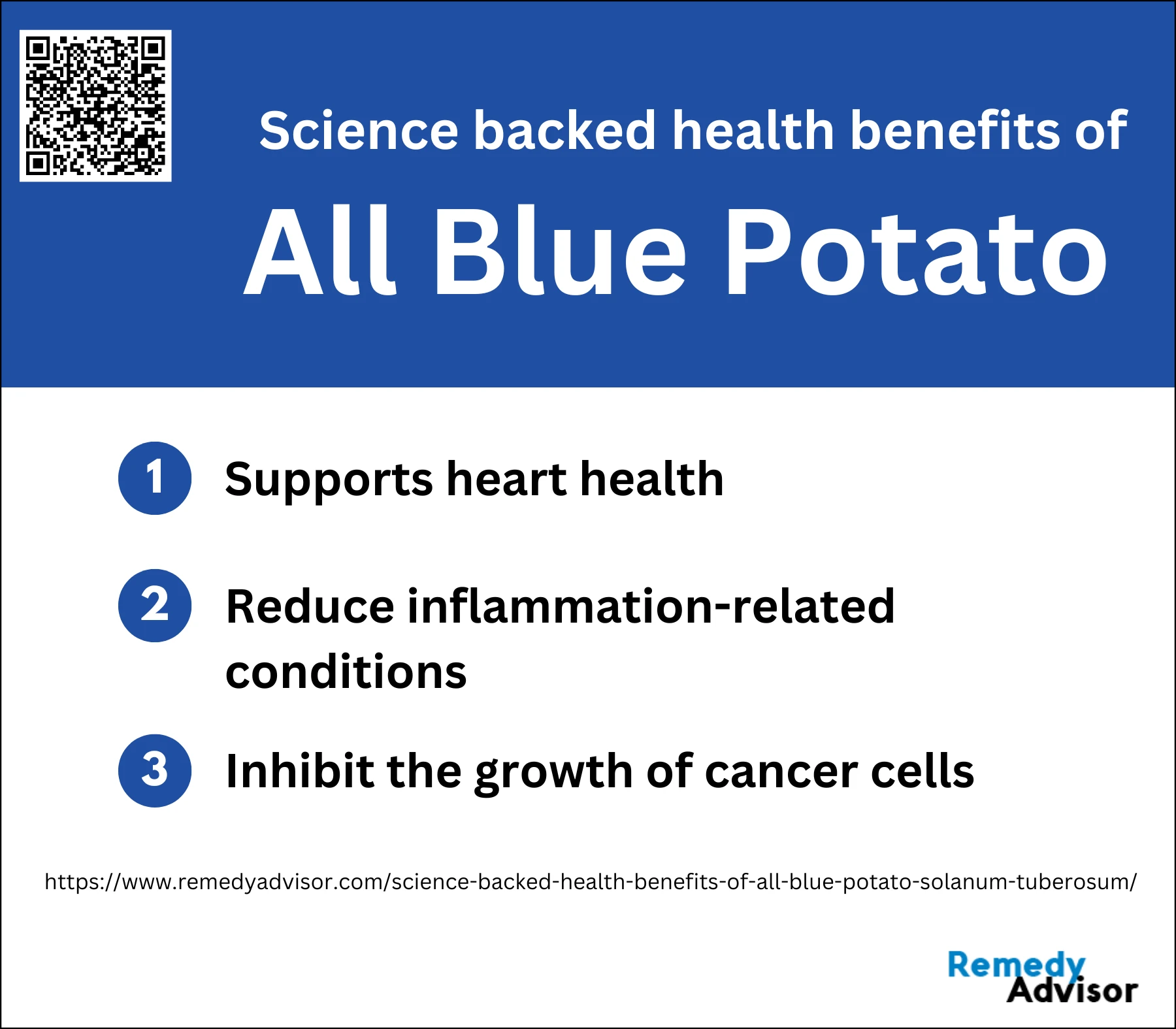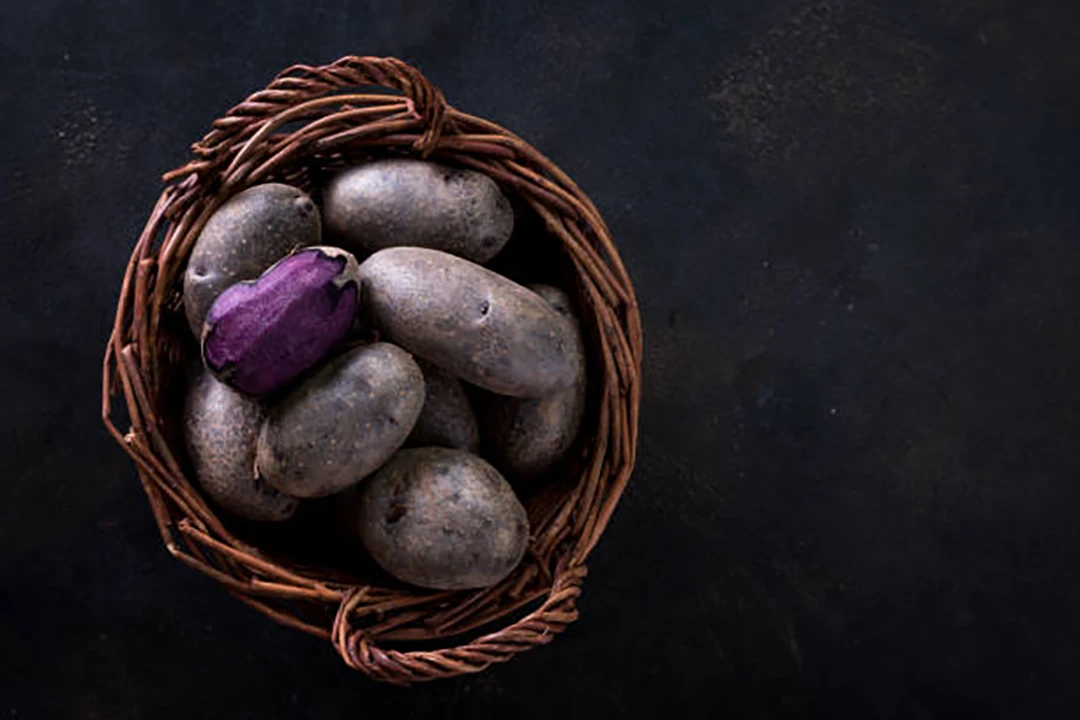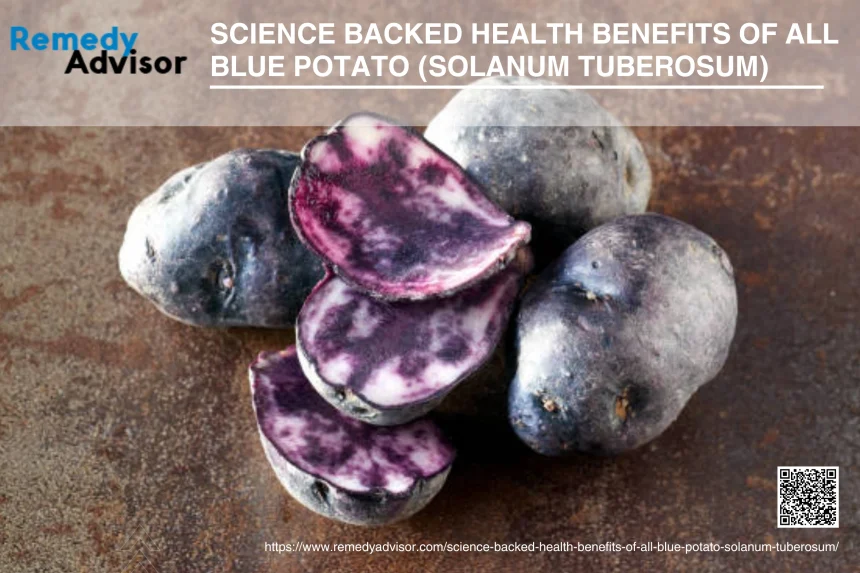The science-backed health benefits of All Blue Potato (Solanum tuberosum) are as vibrant as their striking color. These unique tubers, known for their deep blue to purple hue, are not only a feast for the eyes but also a powerhouse of nutrition. Rich in anthocyanins, the antioxidants responsible for their vivid color, All Blue Potatoes offer a range of health benefits. Studies have shown that these antioxidants can help reduce inflammation, improve cardiovascular health, and even offer potential anti-cancer properties. Additionally, All Blue Potatoes have a lower glycemic index compared to their white counterparts, making them a better option for blood sugar management. With their high fiber content, they also promote digestive health and satiety, making them a valuable addition to a balanced diet. Whether you’re looking to boost your antioxidant intake or simply add a pop of color to your meals, All Blue Potatoes are a nutritious and delicious choice.
What is All Blue Potato ?
The Blue Potato is a cultivated variety of potato that is notable for its unique blue or purple skin and flesh. This variety, like other cultivated potatoes, has a complex evolutionary history and is derived from wild Solanum species native to the Andes of southern Peru. The genetic diversity of the Blue Potato, as with other cultivated potatoes, is significant, encompassing a wide range of alleles due to historic introgressions and hybridization events with wild relatives. The chloroplast genome of Solanum tuberosum, including the Blue Potato, contains a unique 241-bp deletion that distinguishes it from wild species such as Solanum bulbocastanum, highlighting its distinct genetic makeup. This genetic diversity is crucial for understanding the evolutionary processes and for breeding programs aimed at improving potato varieties to address food security challenges in the 21st century.
Nutritional Profile of All Blue Potato:
All Blue Potatoes offer a rich nutritional profile that sets them apart from their white counterparts. A 3.5-ounce (100-gram) serving of cooked All Blue Potato with skin provides approximately 87 calories, 2 grams of protein, 20 grams of carbohydrates, and less than 1 gram of fat. This nutrient-dense tuber is an excellent source of energy while being naturally low in sodium and fat, making it a heart-healthy choice for various diets.
Vitamins and minerals content:
All Blue Potatoes are packed with essential vitamins and minerals. They are particularly rich in vitamin C, providing about 14% of the Daily Value (DV) per serving, which supports immune function and collagen production. These vibrant tubers also contain significant amounts of vitamin B6 (18% of the DV), which is crucial for brain development and function. Additionally, All Blue Potatoes are a good source of minerals, including potassium (8% of the DV), which is essential for heart and muscle function, and manganese (6% of the DV), important for metabolism and bone formation.
Antioxidant properties:
The deep blue-purple color of All Blue Potatoes is indicative of their high antioxidant content, particularly anthocyanins. These potatoes contain two to three times more antioxidant activity than white or yellow varieties. The anthocyanins, along with other polyphenols, help protect cells from oxidative stress and may reduce the risk of chronic diseases such as heart disease and certain cancers. Studies have shown that the antioxidants in All Blue Potatoes can inhibit the growth of cancer cells and may have anti-inflammatory properties.
Dietary fiber and its benefits:
All Blue Potatoes are an excellent source of dietary fiber, containing about 3.3 grams per 3.5-ounce (100-gram) serving when cooked with the skin. This fiber content helps promote digestive health by preventing constipation and feeding beneficial gut bacteria. Additionally, the fiber in All Blue Potatoes can help stabilize blood sugar levels, maintain healthy cholesterol levels, and promote a feeling of fullness, which may aid in weight management. Part of the starch in these potatoes is resistant starch, a type of fiber that resists digestion and acts as a prebiotic, further supporting gut health through the production of short-chain fatty acids
Science backed health benefits of All Blue Potato
Discover the vibrant world of All Blue Potatoes, where nutrition meets nature’s artistry. These eye-catching tubers, with their deep blue to purple flesh, aren’t just a colorful addition to your plate – they’re a powerhouse of health benefits backed by scientific research. From potent antioxidants to heart-healthy compounds, All Blue Potatoes pack a nutritional punch that sets them apart from their paler counterparts. In this article, we’ll dive into the fascinating science behind these azure spuds and explore how they can boost your well-being. Get ready to uncover why adding All Blue Potatoes to your diet might just be one of the smartest – and most colorful – health decisions you can make. Let’s peel back the layers on these remarkable tubers and reveal their science-backed secrets for a healthier you.

1. Supports heart health
All Blue Potatoes are a heart-healthy choice, thanks to their rich content of potassium and anthocyanins. Potassium is crucial for regulating blood pressure, a key factor in cardiovascular health, as it helps to counteract the effects of sodium and ease tension in blood vessel walls. Additionally, the anthocyanins in All Blue Potatoes, which give them their distinctive color, have powerful antioxidant properties that reduce inflammation and improve blood vessel function. Consuming purple potatoes can lower both systolic and diastolic blood pressure, reduce arterial stiffness, and decrease markers of inflammation, all of which contribute to a healthier heart. By incorporating these vibrant tubers into your diet, you can enjoy their unique flavor while supporting your cardiovascular wellness.
What Research Says?
- Potatoes, like the All Blue kind, give us important nutrients. These include vitamin C, potassium, and fiber. They help keep our hearts healthy. Potatoes also have antioxidants. These fight stress and swelling in our bodies, which can lead to heart diseases.
- Chronic inflammation can lead to heart diseases. Potatoes have antioxidants like phenolics and carotenoids. These can fight inflammation and may lower the risk.
- Potatoes have special substances like ACE-inhibitory peptides. These can help lower blood pressure by blocking an enzyme called ACE. These substances are strong in potato proteins and leftovers. This makes potatoes good for making health foods for the heart.
2. Reduce inflammation-related conditions
All Blue Potatoes have shown promising potential in reducing inflammation-related conditions, thanks to their rich content of anthocyanins and other antioxidants. These vibrant blue-purple tubers are packed with bioactive compounds that have been linked to anti-inflammatory effects in the body. The anthocyanins, which give the potatoes their distinctive color, are particularly noteworthy for their ability to combat oxidative stress and inflammation at the cellular level. Consuming foods high in anthocyanins, like All Blue Potatoes, may help alleviate symptoms associated with chronic inflammatory conditions such as arthritis and inflammatory bowel diseases. Additionally, the antioxidants in these potatoes can help neutralize free radicals, which are known to contribute to inflammation and various chronic diseases.
What research Says?
- Potato juice (PJ) is left over when making starch. It has many helpful compounds that can fight inflammation, germs, and cancer. It can also help with weight loss, diabetes, high cholesterol, and high blood pressure. PJ is useful for food and health uses because of these benefits.
- Scientists have tested the liquid from potato tubers mixed with alcohol to see if it can reduce swelling in animals. Research shows that this potato mixture greatly lowers swelling caused by certain chemicals in mice. These results suggest that potato extracts might help ease pain from swelling. They also give ideas for making new treatments for diseases with inflammation.
- Potatoes and their parts can be good for heart health. They may help lower blood pressure, make lipid profiles better, and reduce signs of inflammation. While there’s not much data on how potatoes affect blood sugar after meals and weight control, the studies we have suggest that potatoes can fit into a diet that’s good for heart health.
- Researchers have looked at the peel of the Jayoung potato, which is dark purple, for its healing effects on skin conditions like atopic dermatitis (AD). They found that an alcohol-based extract from the peel can make the symptoms less severe. It also lowers the amount of a specific antibody, IgE, in the blood and reduces the number of certain immune cells in mice. This treatment also cut down on certain immune signals and helped repair skin proteins. These findings suggest it could help treat AD.
3. Inhibit the growth of cancer cells

All Blue Potatoes have shown promising potential in inhibiting the growth of cancer cells, thanks to their rich content of anthocyanins and other bioactive compounds. The polyphenol and anthocyanin-rich extracts from these pigmented potatoes have been found to induce apoptosis (programmed cell death) in cancer cells by activating specific apoptotic players such as caspases and poly (ADP-ribose) polymerase (PARP). Additionally, these extracts have shown the ability to modulate cell cycle progression and inhibit cancer cell proliferation.
What Research Says?
- Study has shown that potato extracts can stop cancer cells from growing. For example, extracts from 13 different kinds of potatoes were tested on colon cancer cells. Three types with color (CO97226-2R/R, CO97216-1P/P, CO04058-3RW/RW) worked really well at stopping the cancer cells from growing. But not all colored potatoes did this. Young potatoes were better at it than older ones. Also, potato flowers and skins stopped cancer cell growth even with a little bit of extract. The study found that raw potato extracts worked better than cooked ones. However, some potatoes still stopped cancer after being cooked.
- A study looked at how extracts rich in polyphenol and anthocyanin (PAE) from colored potato types affect cancer cells. These potatoes included “Blue Star,” “Magenta Love,” and “Double Fun,” as well as the well-studied “Vitelotte.” The research found that PAE made specific proteins, like caspase 8, 9, 3, and PARP, more active in U937 human leukemia cells. It also caused some cells to change into monocytes and granulocytes. The team found polyphenolic compounds, such as caffeoyl and feruloyl quinic acids, and various acylated anthocyanins in the potatoes. Both “Blue Star” and “Vitelotte” had strong effects, while “Double Fun” had little or no effect.
Culinary Uses and Tips:
All Blue Potatoes are as versatile in the kitchen as they are visually striking. These vibrant tubers can be prepared using various cooking methods, including roasting, boiling, mashing, and frying. Roasting brings out their nutty flavor and creates a crispy exterior, while boiling is ideal for potato salads or as a base for mashed potatoes. Their firm texture makes them excellent for grilling or using in casseroles and gratins. All Blue Potatoes can also be sliced thinly and baked into colorful chips or wedges for a healthier alternative to traditional fries.

Popular ways to cook and incorporate All Blue Potato into meals:
All Blue Potatoes can add a pop of color and nutrition to many dishes. They make an excellent addition to roasted vegetable medleys, providing a striking contrast to orange carrots or yellow squash. Mashed All Blue Potatoes can be used as a unique topping for shepherd’s pie or as a side dish for roasted meats. In potato salads, their vibrant hue creates an eye-catching presentation, especially when combined with other colorful ingredients. They can also be incorporated into soups and stews, adding both visual appeal and a hearty texture. For a creative twist, try using them in gnocchi or as a colorful base for loaded potato skins.
Tips for preserving nutritional value during cooking:
To maximize the nutritional benefits of All Blue Potatoes, it’s important to use cooking methods that preserve their nutrients. Steaming or microwaving with minimal water helps retain water-soluble vitamins like vitamin C. When boiling, keep the skin on to prevent nutrient loss and use the cooking water in soups or sauces to capture any leached nutrients. Roasting or air frying with a small amount of healthy oil can help preserve heat-sensitive nutrients while enhancing flavor. Avoid overcooking, as prolonged exposure to heat can degrade some vitamins. Finally, consuming the skin, which contains a significant portion of the potato’s fiber and antioxidants, can further boost the nutritional value of your meal.
Recipe ideas highlighting the versatility of All Blue Potato:
All Blue Potatoes can star in a variety of innovative recipes. For a colorful twist on a classic, try a Blue Potato Gratin layered with herbs and cheese. A vibrant Blue Potato Salad with a tangy vinaigrette and fresh herbs makes for a stunning side dish at summer gatherings. For a hearty main course, stuff halved All Blue Potatoes with a savory mixture of vegetables and cheese, then bake until golden. Create a visually striking soup by pureeing roasted All Blue Potatoes with garlic and cream. For a unique appetizer, slice them thinly and bake into crispy blue potato chips served with a homemade dip. These versatile potatoes can even be incorporated into baked goods, adding moisture and a subtle earthy flavor to breads or savory muffins.
Conclusion
In conclusion, All Blue Potatoes offer a unique combination of visual appeal, culinary versatility, and impressive health benefits. These vibrant tubers are not only rich in essential nutrients like vitamin C, potassium, and dietary fiber, but also pack a powerful punch of antioxidants, particularly anthocyanins, which give them their distinctive blue-purple hue. Scientific research has shown that incorporating All Blue Potatoes into your diet may support heart health, reduce inflammation, and potentially inhibit cancer cell growth. Their versatility in the kitchen allows for a wide range of delicious and nutritious preparations, from colorful potato salads to hearty soups and crispy chips. By choosing All Blue Potatoes, you’re not only adding a pop of color to your plate but also boosting your overall health with their unique nutritional profile and bioactive compounds.
ADDITIONAL RESOURCES
Here are some US organizations involved in vegetable research, along with their short descriptions and URLs:
1. Feed the Future Innovation Lab for Horticulture at UC Davis
This lab focuses on enhancing productivity, post-harvest management, and market access for various vegetables, including African indigenous vegetables. They conduct research and provide training to improve nutrition and income for smallholder farmers.
Recommendations for books on All Blue potatoes.
Here are some book recommendations on the research and cultivation of All Blue potatoes:
1. “Potatoes, Nutrition and Health“
This book offers a comprehensive look at the nutritional benefits of potatoes, including the All Blue variety. It covers the essential vitamins and minerals found in potatoes and their health impacts.
2. “The Blue or Peruvian Potato: History and Nutritional Value“
This book delves into the history and nutritional aspects of blue potatoes, focusing on their origin and health benefits.
FAQS
- What are the main nutritional benefits of All Blue Potatoes?
All Blue Potatoes are rich in essential nutrients, including vitamin C, potassium, vitamin B6, and dietary fiber. They also contain high levels of antioxidants, particularly anthocyanins, which give them their distinctive blue-purple color. - How do All Blue Potatoes support heart health?
All Blue Potatoes support heart health through their high potassium content, which helps regulate blood pressure, and their anthocyanins, which reduce inflammation and improve blood vessel function. Studies have shown they can lower both systolic and diastolic blood pressure and decrease arterial stiffness. - Can All Blue Potatoes help reduce inflammation in the body?
Yes, All Blue Potatoes have shown potential in reducing inflammation-related conditions due to their high content of anthocyanins and other antioxidants. These compounds combat oxidative stress and inflammation at the cellular level. - Do All Blue Potatoes have anti-cancer properties?
Research suggests that All Blue Potatoes may have anti-cancer properties. Extracts from these potatoes have been found to induce apoptosis (programmed cell death) in cancer cells and inhibit cancer cell proliferation. - How do All Blue Potatoes compare to white potatoes in terms of antioxidant content?
All Blue Potatoes contain two to three times more antioxidant activity than white or yellow varieties, primarily due to their high anthocyanin content. - Are All Blue Potatoes beneficial for digestive health?
Yes, All Blue Potatoes are an excellent source of dietary fiber, which promotes digestive health by preventing constipation and feeding beneficial gut bacteria. They also contain resistant starch, which acts as a prebiotic. - Can All Blue Potatoes help with weight management?
The fiber content in All Blue Potatoes can promote a feeling of fullness, which may aid in weight management. Additionally, they are naturally low in fat and sodium. - How do All Blue Potatoes affect blood sugar levels?
The fiber in All Blue Potatoes, particularly the resistant starch, can help stabilize blood sugar levels. However, more research is needed on their specific effects on postprandial glucose response. - What are the best cooking methods to preserve the nutritional value of All Blue Potatoes?
To preserve nutrients, it’s best to steam or microwave All Blue Potatoes with minimal water. Roasting or air frying with a small amount of healthy oil can also help retain heat-sensitive nutrients while enhancing flavor. - Can All Blue Potatoes be part of a heart-healthy diet?
Yes, studies suggest that All Blue Potatoes can be part of a heart-healthy diet. They may help lower blood pressure, improve lipid profiles, and reduce markers of inflammation, all of which contribute to better cardiovascular health.







